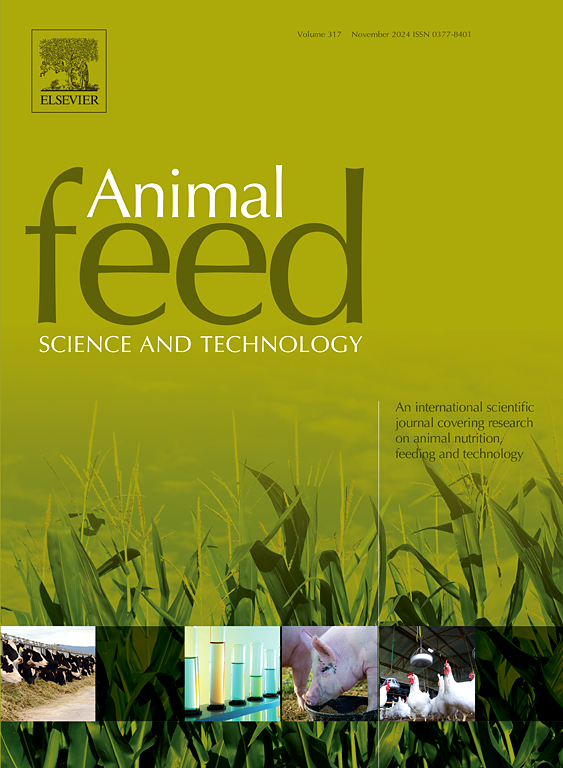Modeling microbial growth based on time-dependent kinetic mechanisms of digestion and passage in the ruminoreticulum
IF 2.5
2区 农林科学
Q1 AGRICULTURE, DAIRY & ANIMAL SCIENCE
引用次数: 0
Abstract
The original Cornell Net Carbohydrate and Protein System (CNCPS) model, which was developed in 1992 and revised in 2004, included a rumen submodel with a set of equations that were algebraically programmed in a spreadsheet to predict bacterial N flow to the caudal tract of cattle. In this study, we propose a modification to the original CNCPS rumen submodel based on mathematical concepts that simulate the flow paths of solids and liquid in the rumen, which are known to be essential factors affecting rumen fermentation and microbial growth. This modification allows the quantification of the impact of aging mechanisms on the availability of both soluble and insoluble substrates for microbial growth in the rumen. Additionally, a correction has been proposed on peptide uptake by rumen bacteria. Literature data were used to evaluate the model adequacy of CNCPS versions 1992 and 2004, along with the proposed model, to determine their ability to predict bacterial N flow. The proposed model more accurately predicted the variable of interest, but there was an overall underprediction bias. Despite the rightful critics of the ability of mechanistic models to predict microbial crude protein flow from the rumen, the 1992 and 2004 versions of the CNCPS and the proposed modifications implemented within the CNCPS framework led to predictions that agreed with observational data at a discordance rate of 0.05, tolerance probabilities <0.001 for versions 1992 and 2004, and a tolerance probability equal to 0.13 for the proposed model given a sample size . Therefore, the proposed modifications might improve the ability of CNCPS-based models to predict the bacterial N flow from the rumen, thereby resulting in improved predictive performance compared to the original CNCPS model. Thus, it seems that models built on time-dependent kinetics of food particles and fluid are more fitting than time-independent ones to predict bacterial N flow to the caudal tract.
根据反刍动物体内消化和通过的时间相关动力学机制建立微生物生长模型
最初的康奈尔净碳水化合物和蛋白质系统(CNCPS)模型开发于 1992 年,2004 年进行了修订,其中包括一个瘤胃子模型,该模型通过在电子表格中对一组方程进行代数编程来预测流向牛尾道的细菌氮。在本研究中,我们基于模拟瘤胃中固体和液体流动路径的数学概念,对最初的 CNCPS 瘤胃子模型提出了修改建议,众所周知,固体和液体是影响瘤胃发酵和微生物生长的重要因素。这种修改可以量化老化机制对瘤胃中微生物生长所需的可溶性和不可溶性基质的影响。此外,还对瘤胃细菌对肽的吸收进行了修正。文献数据被用来评估 CNCPS 1992 和 2004 版模型的适当性,以及所提议的模型,以确定它们预测细菌氮流量的能力。建议的模型能更准确地预测相关变量,但总体上存在预测不足的偏差。尽管有人对机理模型预测瘤胃微生物粗蛋白流量的能力提出了合理的批评,但在样本量为 n=39 的情况下,1992 和 2004 版 CNCPS 以及在 CNCPS 框架内实施的拟议修改所得出的预测结果与观测数据一致,不一致率为 0.05,1992 和 2004 版的误差概率为 0.001,而拟议模型的误差概率等于 0.13。因此,建议的修改可能会提高基于 CNCPS 的模型预测瘤胃细菌氮流的能力,从而使其预测性能优于原始 CNCPS 模型。由此看来,基于食物颗粒和流体的时间相关动力学建立的模型比时间无关模型更适合预测细菌氮流向尾道的情况。
本文章由计算机程序翻译,如有差异,请以英文原文为准。
求助全文
约1分钟内获得全文
求助全文
来源期刊

Animal Feed Science and Technology
农林科学-奶制品与动物科学
CiteScore
6.00
自引率
6.20%
发文量
266
审稿时长
3 months
期刊介绍:
Animal Feed Science and Technology is a unique journal publishing scientific papers of international interest focusing on animal feeds and their feeding.
Papers describing research on feed for ruminants and non-ruminants, including poultry, horses, companion animals and aquatic animals, are welcome.
The journal covers the following areas:
Nutritive value of feeds (e.g., assessment, improvement)
Methods of conserving and processing feeds that affect their nutritional value
Agronomic and climatic factors influencing the nutritive value of feeds
Utilization of feeds and the improvement of such
Metabolic, production, reproduction and health responses, as well as potential environmental impacts, of diet inputs and feed technologies (e.g., feeds, feed additives, feed components, mycotoxins)
Mathematical models relating directly to animal-feed interactions
Analytical and experimental methods for feed evaluation
Environmental impacts of feed technologies in animal production.
 求助内容:
求助内容: 应助结果提醒方式:
应助结果提醒方式:


